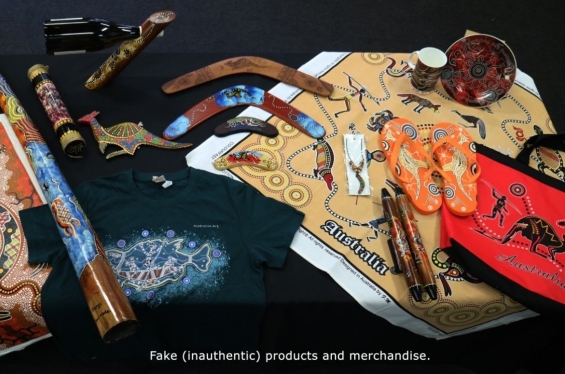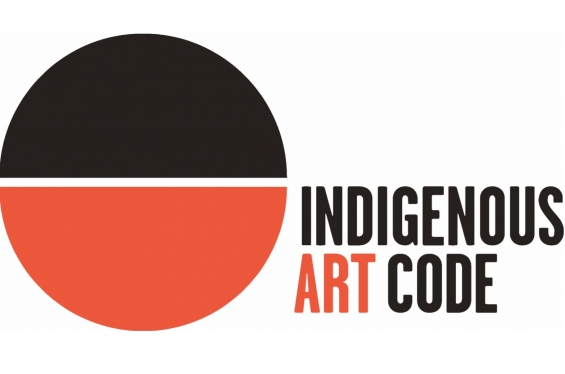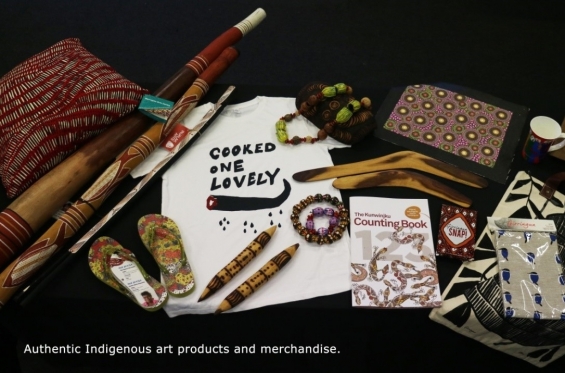You may be surprised to learn fake Aboriginal Art is a multimillion dollar industry, imported from countries such as Indonesia or China.
If you’re looking to buy genuine Aboriginal Art, that means you first need to ensure it’s genuine, and then you need to consider the ethical aspects of buying from our indigenous community.
We spoke to Gabrielle Sullivan, CEO of the Indigenous Art Code to do some myth busting about the complexities of buying Aboriginal and Torres Strait Islander art in Australia.
Ms Sullivan, a passionate and formidable woman, shares with us ways we can be confident that the money you spend on an artwork actually reaches the artist.
The real deal, it appears, can be hard to find in a sea of appropriation. How can we navigate these murky waters? We also talk to Gabrielle about the Fake Art Harms culture campaign and changes to Federal legislation.
- Fake Aboriginal Art – A Multimillion Dollar Industry
- How to tell if Aboriginal Art is Authentic?
- The Questions You Should Ask When Buying Aboriginal Art
- Red Flags in Buying Aboriginal Art
- How Does Fake Aboriginal Art Impact the Style?
- Fake Art Harms Culture (FAHC) – Campaigning to Protect Genuine Aboriginal Art
- Protecting the Future of Aboriginal Art
- Further Reading
“So let’s pretend that you are a tourist travelling in WA or perhaps you would like connect to Indigenous Australian culture by purchasing a piece of Aboriginal art. You’ve heard stories about artists not always receiving fair money for their artwork and sometimes, that the artwork isn’t made by an Aboriginal artist at all. Don’t let this put you off purchasing an artwork or souvenir. There is so much fantastic and affordable genuine product out there, make it your mission to make sure you are getting the real deal and the artist is getting a good deal. Pressure from the consumer can help to reclaim this place in the market by Aboriginal artists and ethical businesses that support them.”
Gabrielle Sullivan, CEO Indigenous Art Code
Fake Aboriginal Art – A Multimillion Dollar Industry
Regrettably, it is a fact that there is a considerable amount of “fake” Aboriginal art and craft product available in Australia largely in the market targeting tourists with artwork at lower price points.
The tourist trade for Aboriginal art across Australia should represent a bustling industry for remote community artists. But how can these artists and their art centres compete when they have to exist in the same market as a fake product?

Frank Robson states in the weekend magazine for the Sydney morning Herald that roughly 80% of the so-called Aboriginal souvenirs are made in Indonesia or China.
The trade of these “cut-price counterfeits” was pioneered by a few opportunistic white entrepreneurs in the 1990s, and is now believed to be a multimillion dollar industry.
Gabrielle and the Indigenous Art Code are working to address these issues:
“The fake stuff is so prevalent now that tourists have come to think it’s the real thing…. the worst thing is that this stuff is just so bloody insulting to the people it’s supposed to represent. The answer is; they struggle to engage at that end of the market. It is difficult to compete when the price of the “fake” product is so cheap and readily available to retailers buying product in bulk. Unfortunately, it is not illegal to mass produce boomerangs, didgeridoos, clap sticks and sometimes paintings. It is very difficult for a business that pays artists fairly and ensures Indigenous Cultural Intellectual property is respected to compete with a business that doesn’t.”
How to tell if Aboriginal Art is Authentic?
Firstly, look for the Indigenous Art Code logo (pictured below). This means the dealer is a member of the Code.
The Code is a voluntary Code of conduct and not a certification labelling system to demonstrate authenticity of product, but you can be assured that businesses who are members have agreed to abide by the objectives of the Code.

The purpose of the Code is to establish standards for dealings between Dealers and Artists to ensure:
- Fair and ethical trade in Artwork.
- Transparency in the process of promotion and sale of Artwork.
- Disputes arising under the Code are dealt with efficiently and fairly.
Products will also often have the Australian Made logo on them.
Remember, Australian Made does not mean made or licensed by an Aboriginal artist!
The requirement for the Australian made criteria does not include ensuring the artist is fairly renumerated under a licensing agreement, or that Aboriginal and Torres Strait Islander Intellectual property is valued and respected.
Lots of the fake boomerangs and other products will have “Hand Painted” and “Australia” and “Aboriginal” written on them, but they rarely say hand painted by an Aboriginal Artist in Australia!
The Questions You Should Ask When Buying Aboriginal Art
It goes without saying the more due diligence you invest in, the more confidence you will have in an art purchase.
Below are what I consider the most important five questions you should always ask when buying Aboriginal art:
- Who is the artist?
- Where is the artist from?
- How does the artist get paid, what percentage of the total sales price does the artist receive?
- In the case of original (not licensed merchandise product) how did you obtain the work – did you buy it outright or is it consigned to your gallery? Is this the first time the work has been sold?
- In the case of merchandise or a licensed product (not one off original works) is there a licensing agreement with the artist?
Have you purchased Aboriginal art? How does the information above cause you to consider your previous purchase?
Red Flags in Buying Aboriginal Art
To add to the above, when buying in a shop or gallery, consider the following as red flags (or at the very least areas of concern):
- The staff cannot tell you who the artist is or where they are from.
- The staff cannot provide you with information about how the artist is paid. An ethical operator will not have any issue with sharing information with you about the supply chain and how the work you are considering purchasing ended up in your hands.
- They tell you that “it’s painted for the tourist market” or “a group of artists painted it, we don’t have the individual’s name”.
- If something says handmade, hand painted and there are 100’s of other almost identical products be wary and ask questions.
- If your gut is telling you something is suspicious it probably is, be extra careful.
How Does Fake Aboriginal Art Impact the Style?
The production of these inauthentic products has a direct negative impact in at least four ways:
- Misappropriates Aboriginal and Torres Strait Islander culture and undermines the role of Aboriginal and Torres Strait Islander communities.
- Denies Aboriginal and Torres Strait Islander artists of economic and other opportunities.
- Deceives consumers.
- Disadvantages Australian businesses who take an ethical and culturally empathetic approach to their work.
Fake Art Harms Culture (FAHC) – Campaigning to Protect Genuine Aboriginal Art
In 2016, following representations by Indigenous community members and artists, The Indigenous Art Code (IAC) with Arts Law and Copyright Agency l Viscopy began to explore how to best respond to concerns about the growing presence of inauthentic “Aboriginal style” art and craft products and merchandise for sale across Australia.
In response to the concerns, the “Fake Art Harms Culture” (FAHC) campaign was created to address the widespread sale of works that have the look and feel of being Indigenous but actually have no connection to Aboriginal and Torres Strait Islander communities.
The FAHC campaign conducted a shopping exercise in tourist locations in various Australian capital cities and regional towns. It found very large numbers of inauthentic items and estimates suggest this is a multi-million-dollar market. The FAHC also found items which sellers advised were authentic, but they could not verify their claims.
These are largely commercially produced goods, generally aimed at the tourist market; often made from non-traditional materials; and featuring inauthentic and culturally inappropriate designs.
Decades of work done by Aboriginal and Torres Strait Islanders artists communities, peak organisations and advocates started the ball rolling; acknowledging their hard work as the foundations of the movement.
The FAHC campaign immediately gained support from industry peak bodies and artists.
In January 2017 a few months after the campaign was launched; Gabrielle was contacted by the office of Federal member for Kennedy, Mr Bob Katter. Mr Katter publicly threw his support behind the campaign and introduced Competition and Consumer Amendment (Exploitation of Indigenous Culture) Bill in 2017.
Mr Katter said to the ABC “They are purporting to be First Australian products and they’re not … there is a deceit upon the public of Australia.”
Since the introduction of Mr Katter’s bill there has been continued support for the campaign and to address the issues from individual artists, art centres, ethical dealers, consumers and individuals who don’t think it should be legal to steal Aboriginal and Torres Strait Islander culture.
Hundreds of individual letters and post cards were sent to Minister Nigel Scullion, then there was the announcement of a parliamentary Inquiry into the growing presence of inauthentic Aboriginal and Torres Strait Islander “style” art and craft products and merchandise for sale across Australia in August 2017.
There has been well researched and consistent media coverage of the issue over the past years, and this continues.
These new laws have the potential to change the livelihoods of artists and communities, whilst being able to better protect the Aboriginal and Torres Strait Islander art sector.
What should we be on the lookout for when purchasing and how can we better educate ourselves?
Protecting the Future of Aboriginal Art
The Fake Art Harms Culture campaign was a huge success, but the issues around fake Aboriginal art continues to be a huge journey.
What is the current thinking around changing legislation?
There is no one single solution to addressing this issue but we do believe that amending the existing Australian Consumer Law is a good place to start. In Australia Indigenous culture is unfairly misappropriated for commercial gain, provided consumers are not misled. The Indigenous Art Code (IAC) supports the concept that to be considered ‘authentic’* products should either be made by, or under licence from, Indigenous artists.
It considers it important that to be classified “authentic” any merchandise being made by non-Indigenous people, including overseas, must be made with the full authority of Aboriginal and Torres Strait Islander artists / people and with an income being returned to the artists.
For example, Fine Bone China plates, mugs, bowls etc. which have artwork reproduced on them should meet the following conditions:
- The artist is attributed, including reference to the original artwork.
- The integrity (moral rights) of the artist has been respected.
- The artist has a received a fair licensing fee /payment under a transparent licensing agreement.
- The artist has had the opportunity to access legal advice on the terms of the contract or agreement.
* The term authentic is not one used by most Aboriginal and Torres Strait Islander artists in relation to the work they create. The work they create belongs to them. The ICIP imbedded in those works belongs to them.
It should be noted that the words authentic and inauthentic are predominantly used by a non-Indigenous audience to understand this issue.
We hope the Australian Government will look at ways to strengthen the existing Australian Consumer Law.
Further Reading
More on the code:
There are three categories of the Indigenous Art Code membership – Dealer, Artist and Supporter. Membership is free for artists.
If you would like more information have a look at the Indigenous Art Code website.
Rio Tinto are supporters of the Indigenous Art Code, promoting the ethical sale and exhibition of Aboriginal and Torres Strait Islander Art.


Leave a Reply